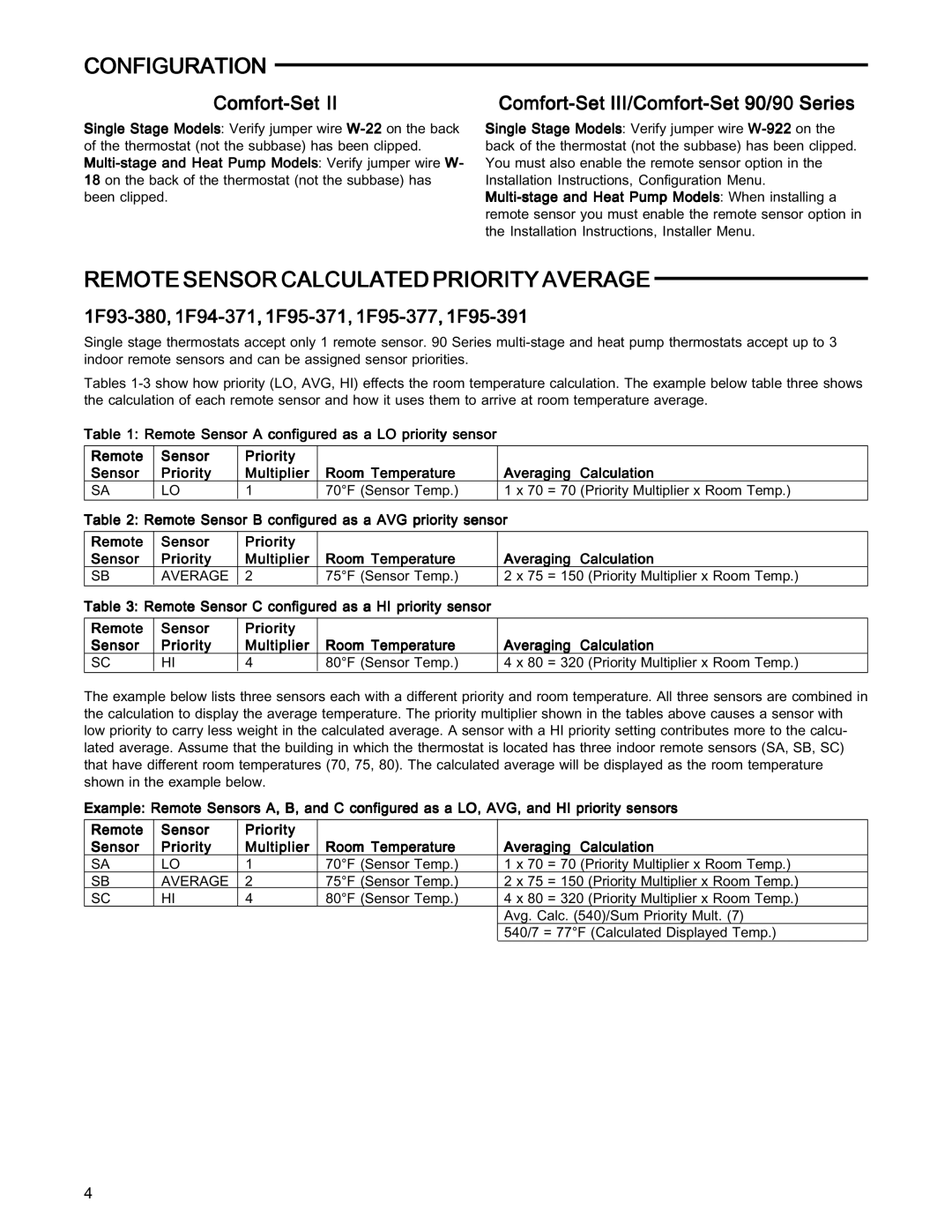
CONFIGURATION
Comfort-Set II
Single Stage Models: Verify jumper wire
Comfort-Set III/Comfort-Set 90/90 Series
Single Stage Models: Verify jumper wire
REMOTE SENSOR CALCULATED PRIORITY AVERAGE
1F93-380, 1F94-371, 1F95-371, 1F95-377, 1F95-391
Single stage thermostats accept only 1 remote sensor. 90 Series
Tables
Table 1: Remote Sensor A configured as a LO priority sensor
Remote | Sensor | Priority |
|
|
|
|
Sensor | Priority | Multiplier | Room Temperature | Averaging | Calculation | |
SA | LO | 1 | 70°F (Sensor Temp.) | 1 x 70 | = 70 (Priority Multiplier x Room Temp.) | |
Table 2: Remote Sensor B configured as a AVG priority sensor |
|
| ||||
|
|
|
|
|
|
|
Remote | Sensor | Priority |
|
|
|
|
Sensor | Priority | Multiplier | Room Temperature | Averaging | Calculation | |
SB | AVERAGE | 2 | 75°F (Sensor Temp.) | 2 x 75 | = 150 (Priority Multiplier x Room Temp.) | |
Table 3: Remote Sensor C configured as a HI priority sensor |
|
|
| |||
|
|
|
|
|
|
|
Remote | Sensor | Priority |
|
|
|
|
Sensor | Priority | Multiplier | Room Temperature | Averaging | Calculation | |
SC | HI | 4 | 80°F (Sensor Temp.) | 4 x 80 | = 320 (Priority Multiplier x Room Temp.) | |
The example below lists three sensors each with a different priority and room temperature. All three sensors are combined in the calculation to display the average temperature. The priority multiplier shown in the tables above causes a sensor with low priority to carry less weight in the calculated average. A sensor with a HI priority setting contributes more to the calcu- lated average. Assume that the building in which the thermostat is located has three indoor remote sensors (SA, SB, SC) that have different room temperatures (70, 75, 80). The calculated average will be displayed as the room temperature shown in the example below.
Example: Remote Sensors A, B, and C configured as a LO, AVG, and HI priority sensors
Remote | Sensor | Priority |
|
|
|
Sensor | Priority | Multiplier | Room Temperature | Averaging Calculation | |
SA | LO | 1 | 70°F (Sensor Temp.) | 1 x 70 | = 70 (Priority Multiplier x Room Temp.) |
SB | AVERAGE | 2 | 75°F (Sensor Temp.) | 2 x 75 | = 150 (Priority Multiplier x Room Temp.) |
SC | HI | 4 | 80°F (Sensor Temp.) | 4 x 80 | = 320 (Priority Multiplier x Room Temp.) |
|
|
|
| Avg. Calc. (540)/Sum Priority Mult. (7) | |
|
|
|
| 540/7 = 77°F (Calculated Displayed Temp.) | |
4
